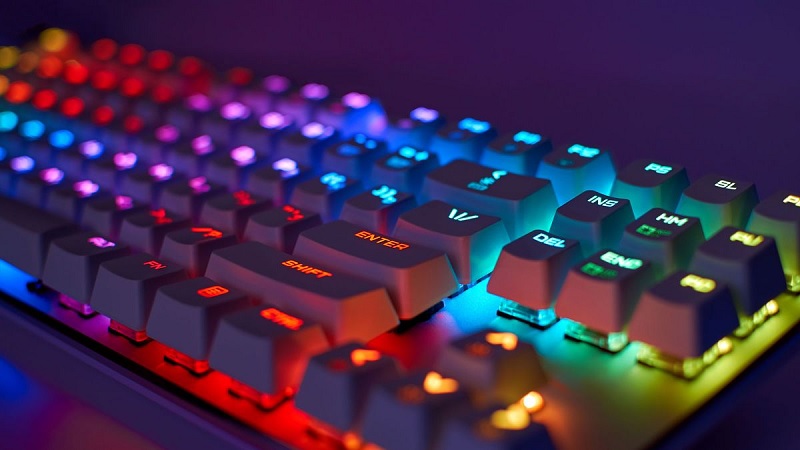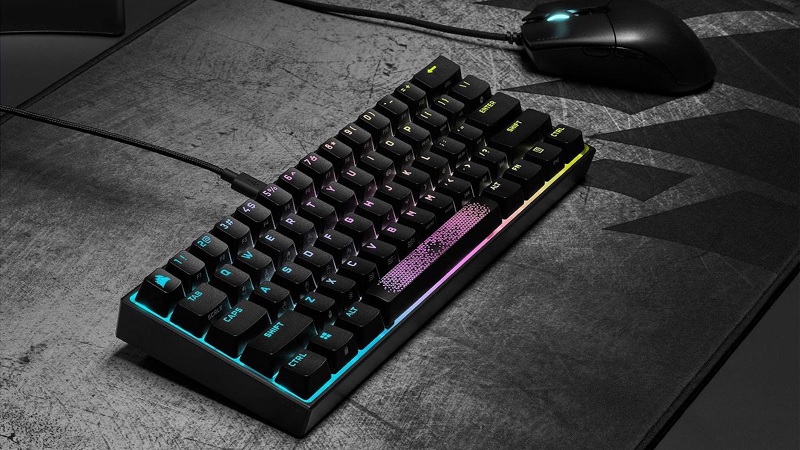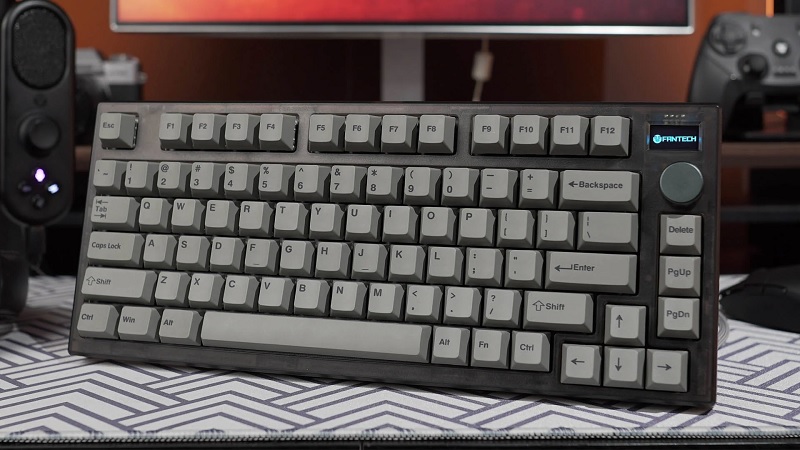Mechanical Keyboard Tester: Check Full, TKL, 75% Keyboards Online
To test a mechanical keyboard, start by checking the switches. Identify if they’re tactile, linear, or clicky, and assess their actuation force and durability. Next, evaluate key features like keystroke force and travel distance, and pay attention to tactile feedback and keycap material.
Don’t forget to assess typing noise and latency; tools can help measure these precisely. Test in a distraction-free environment for accurate results. Also, perform key rollover tests to ensure no ghosting or missed inputs.
Troubleshoot any issues by checking connections, updating firmware, and cleaning switches. By exploring these steps, you’ll find more ways to refine your testing.
The Mechanical Keyboard Test Mechanism

When you’re testing mechanical keyboards, it’s crucial to understand the mechanisms that determine their performance. The heart of any mechanical keyboard is its switches. These switches come in various types, including tactile, linear, and clicky. Each type offers a different feel and sound, which can significantly affect your typing experience.
Firstly, you’ll want to familiarize yourself with the actuation force, which is the amount of pressure needed to press a key. This varies across switches and influences how responsive the keyboard feels. Another important factor is the actuation point, the specific point at which the keypress is registered. Understanding these aspects helps you judge the keyboard’s efficiency and suitability for your needs.
Additionally, consider the debounce time, the delay between key presses that prevents erroneous multiple registrations. A shorter debounce time is generally better for faster, more accurate typing. Understanding these technical elements allows you to make informed decisions about what kind of mechanical keyboard suits your requirements.
Lastly, test the durability of the switches. Most switches are rated for a certain number of keypresses, typically ranging from 50 million to 100 million. Knowing this can give you an idea of the keyboard’s longevity.
Key Features to Test

When testing mechanical keyboards, you’ll want to focus on several key features. Pay attention to keystroke testing, typing experience, typing noise, and latency. These aspects will help you determine the overall performance and suitability of the keyboard for your needs.
Keystroke Testing
To ensure a mechanical keyboard meets your needs, you should test key features such as actuation force, key travel distance, and tactile feedback. Actuation force is the amount of pressure you need to apply for a key to register.
Different switches have varying actuation forces, so if you prefer a lighter touch, look for switches that require less force. On the other hand, if you like a more substantial feel, opt for ones with higher actuation force.
Key travel distance is another critical aspect. This is the distance a key moves from its resting position to when it’s fully pressed. Mechanical keyboards often have deeper key travel compared to membrane keyboards, which some users find more comfortable and precise. Testing this will help you determine if the travel distance feels right for your typing style.
Lastly, tactile feedback is essential. Some switches offer a noticeable bump when a key is actuated, providing physical feedback. Others are linear and smooth, with no tactile bump. If you enjoy feeling exactly when a keypress is registered, go for tactile switches.
If you prefer a smoother experience, linear switches might be your best bet. Testing these features will help you find the perfect keyboard for your needs.
Typing Experience
Now that you’ve explored keystroke testing, let’s focus on the overall typing experience by examining key features like switch type, keycap material, and keyboard layout. The switch type directly impacts how the keys feel under your fingers. Whether you prefer the tactile bump of Brown switches, the clicky feedback of Blue switches, or the smooth linear feel of Red switches, knowing your preference is critical.
Next, consider the keycap material. ABS plastic is common but can become shiny with use, whereas PBT plastic is more durable and resistant to wear. The texture and thickness of the keycaps also affect your typing comfort and accuracy.
Lastly, the keyboard layout plays a significant role. Do you need a full-sized keyboard with a number pad, or would a tenkeyless (TKL) or 60% layout be more convenient for your space and usage?
Here’s a quick comparison:
| Feature | Options | Considerations |
|---|---|---|
| Switch Type | Blue, Brown, Red | Tactile feedback, noise level, actuation |
| Keycap Material | ABS, PBT | Durability, texture, resistance to shine |
| Layout | Full, TKL, 60% | Space-saving, functionality, portability |
Typing Noise
During your quest for the perfect mechanical keyboard, paying attention to typing noise is crucial for both personal comfort and workplace harmony. The sound of key presses can vary significantly between different switch types. For example, Cherry MX Blue switches are known for their loud, clicky sound, while Cherry MX Brown switches offer a quieter, tactile feedback. If you work in a shared environment, noisy keys can be distracting to colleagues, so a quieter switch might be preferable.
To test typing noise, start by pressing each key individually and listen to the sound it produces. Repeat this process for rapid typing, as the noise level can change when typing speed increases. You can also record the sound using a smartphone to compare different keyboards or switches more objectively.
Don’t forget to consider the keyboard’s build quality. Metal backplates tend to amplify noise, while plastic ones may dampen it. Some keyboards come with dampening rings or pads that can further reduce noise.
Latency
When evaluating a mechanical keyboard, latency is a key feature that can significantly impact your typing and gaming experience. Latency refers to the delay between pressing a key and the corresponding action appearing on your screen. Lower latency is crucial for gamers who need immediate response times and typists who want a seamless experience.
To test latency, start by looking at the keyboard’s specifications. Many manufacturers list latency times, but real-world testing is essential. Use online tools or software that measure keyboard input lag. These tools often provide a millisecond reading, giving you a precise idea of how fast your keyboard responds.
Next, perform a practical test. Use your keyboard in a fast-paced game or type out a lengthy document. Pay attention to any noticeable delays between your keystrokes and the on-screen action. If you’re testing multiple keyboards, compare their performances side-by-side.
Exploring Different Approaches to Test a Mechanical Keyboard

Selecting the ideal testing method for a mechanical keyboard hinges on understanding your specific needs and preferences. Different users prioritize different aspects, such as key responsiveness, durability, or typing comfort. To make an informed choice, consider these four primary testing methods:
- Key Switch Testing: This involves manually pressing each key to check for consistent feel and sound. It’s crucial for enthusiasts who want to ensure uniformity across all keys.
- Software Testing: Utilize software tools like AquaKeyTest or Switch Hitter to monitor key actuation, ghosting, and rollover. This method’s great if you’re tech-savvy and want precise data on your keyboard’s performance.
- Typing Speed and Accuracy Tests: Online tools like 10FastFingers or TypingTest.com help you evaluate how the keyboard affects your typing speed and accuracy. If you’re a writer or programmer, this can be particularly useful.
- Durability and Stress Tests: These tests simulate prolonged usage and heavy keystrokes to assess how well the keyboard holds up over time. Ideal for gamers or heavy typists who need a keyboard that can withstand intensive use.
Test Environment Setup

To achieve accurate and consistent results, ensure your test environment is free from distractions and maintains a controlled lighting and noise level. Start by choosing a quiet room where you won’t be interrupted. Background noise can influence your perception of the keyboard’s sound and feel, so it’s crucial to minimize it. Turn off any unnecessary electronics or devices that might generate background noise.
Next, pay attention to the lighting. Consistent lighting helps you better observe the keycaps and their legends, particularly if you’re evaluating the backlighting or RGB features of the keyboard. Avoid harsh or fluctuating light sources, as they can create shadows or glare, making it difficult to see the keyboard clearly.
Set up a clean, clutter-free workspace. A tidy environment not only helps you focus but also ensures that nothing obstructs your interaction with the keyboard. Place the keyboard on a stable surface to prevent any unwanted movement during testing.
Lastly, make sure your computer and any necessary software or tools are ready for the tests. Having everything prepared beforehand allows you to focus entirely on the keyboard during the evaluation, leading to more reliable results.
Keyboard Performance Evaluation

With your test environment properly set up, it’s time to evaluate the keyboard’s performance by examining key responsiveness, actuation force, and overall typing experience. Start by paying attention to how quickly each key registers a press. Slow or inconsistent responses can indicate issues with the switch mechanisms or circuitry.
To measure actuation force, you’ll need to press the keys and note the amount of pressure required to register a keystroke. This can be subjective, but you might find tools online or apps that measure this more precisely. A consistent actuation force across all keys is a good sign of quality.
Next, consider the overall typing experience:
- Comfort: Is the keyboard comfortable for extended use? Pay attention to wrist strain and finger fatigue.
- Sound: Some mechanical keyboards are loud, while others are quieter. Ensure the noise level suits your environment.
- Stability: Check if the keyboard stays in place during intense typing sessions. Slipping can disrupt your workflow.
- Switch Type: Different switches offer various tactile feedback. Ensure the switch type matches your preferences, whether they’re linear, tactile, or clicky.
Key Rollover Test
A crucial aspect of testing mechanical keyboards is the key rollover test, which determines how many keys can be pressed simultaneously without causing ghosting or missed inputs. To start, you’ll need a key rollover tool or a dedicated website that can help you test this. Begin by pressing multiple keys at once. Ideally, a good mechanical keyboard should support at least N-key rollover, meaning you can press “N” number of keys simultaneously and all of them will register.
First, try pressing two keys, then three, and keep increasing the number. Notice if any key presses are missed or if extra unintended keys appear (ghosting). This is important for gaming and fast typing where multiple key presses are common. If your keyboard claims to have full N-key rollover, every key should register no matter how many you press at once.
Remember to test keys in different sections of the keyboard—don’t just stick to one area. This will help you ensure that the key rollover capability is consistent across the entire keyboard. Pay attention to any inconsistencies, as they could be indicative of design flaws or hardware issues.
Troubleshooting and Repair
When your mechanical keyboard starts acting up, identifying the root cause is the first step towards effective troubleshooting and repair. Begin by checking if the issue lies with the keyboard itself or the software. Here are some steps to guide you:
- Check Connections: Ensure that the USB cable is securely plugged into your computer. If you’re using a wireless keyboard, verify that the batteries are charged and the receiver is properly connected.
- Test on Another Device: Plug your keyboard into another computer or device. This can help determine if the problem is with the keyboard or your primary computer.
- Inspect Key Switches: If certain keys aren’t responding, remove the keycaps and inspect the switches. Look for dirt or debris and clean them gently with compressed air or a small brush.
- Update Firmware and Drivers: Sometimes, outdated firmware or drivers can cause issues. Visit the manufacturer’s website to download and install any available updates.
Frequently Asked Questions
How Do I Clean My Mechanical Keyboard Properly?
To clean your mechanical keyboard, start by unplugging it. Use a keycap puller to remove the keycaps. Dust them off and soak them in warm, soapy water. While they’re soaking, use compressed air to blow out dust and debris from the keyboard base. Wipe the base with a damp cloth, making sure it’s not too wet. Once everything’s dry, reassemble the keyboard. Don’t forget to test it afterward!
What Are the Common Signs of a Failing Mechanical Keyboard?
You’ll notice a failing mechanical keyboard if some keys stop responding or require extra force to register. Double key presses or inconsistent key actions are also red flags. If the keyboard becomes unresponsive intermittently, it’s another sign. Additionally, unusual noises, like a key getting stuck or not returning to its original position, indicate trouble. Keep an eye out for these common issues to spot a failing keyboard.
How Often Should I Test My Mechanical Keyboard for Performance Issues?
You should test your mechanical keyboard for performance issues every few months, especially if you use it frequently. Regular testing helps you catch any problems early, like unresponsive keys or inconsistent key presses. If you notice any signs of malfunction, like sticking keys or unusual sounds, don’t wait. Addressing issues promptly can prolong your keyboard’s lifespan and ensure a consistent, enjoyable typing experience.
Can I Test a Mechanical Keyboard Without Specialized Tools?
Testing a mechanical keyboard without specialized tools is a piece of cake. You don’t need a magnifying glass to spot a glaring issue. Just use your ears and fingers. Listen for unusual noises or feel for inconsistent key presses. Typing tests online can reveal ghosting or lag. It’s a hands-on approach, so trust your senses, and you’ll catch any gremlins hiding in your keyboard.
How Does Key Switch Type Affect the Testing Process?
Key switch type really impacts the testing process. If you’re testing tactile or clicky switches, you’ll focus on the feel and sound each key makes. For linear switches, you’ll pay more attention to the smoothness and consistency. Don’t forget to check actuation force; different switch types require different pressure levels. You’ll find that understanding switch characteristics helps you better gauge whether the keyboard meets your needs.
Conclusion
Just like a maestro fine-tuning an orchestra, you now have the knowledge to ensure each keystroke on your mechanical keyboard sings in harmony. By testing key features, choosing the right methods, and setting up the ideal environment, your keyboard will perform like a symphony.
Remember, the journey doesn’t end here—master the key rollover test and troubleshoot like a seasoned detective. Your mechanical keyboard deserves nothing less than perfection. Happy typing!

Keyboards-Tester.com is a game-changer! I was having issues with a few keys on my keyboard and wasn’t sure which ones were malfunctioning. This tool made it incredibly easy to diagnose the problem in seconds. The interface is simple and intuitive, with clear instructions on how to test each key.
- Joshua Lee • Head of Technology

Great Tool!
I was messed up with some keys on my keyboard. I was trying to figure out which was making the mess and not working. It took me only one minute to check my keyboard.
- Billy Joe • Entrepreneur